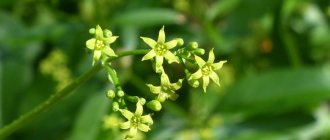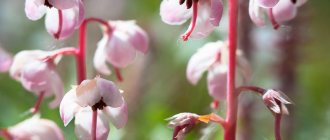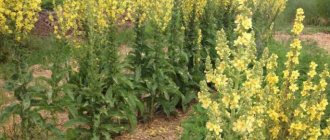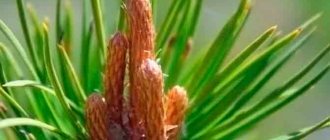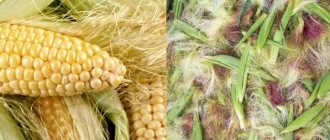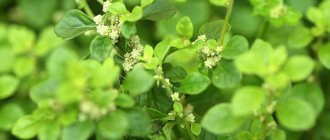Madder (lat. Rubia tinctrum) is a perennial herbaceous plant of the Madder family (Rubiaceae) with a woody horizontal rhizome and branched climbing shoots up to 1.5-2 meters high.
Common names: Georgian madder , petiole madder , speck , krapp , marzana , marina .
The homeland of madder is the Mediterranean, Asia Minor and Central Asia, Eastern Europe: Turkey, Syria, Lebanon, Jordan, Iraq, Iran, Georgia, Azerbaijan, Tajikistan, Turkmenistan, Uzbekistan, Ukraine, the countries of the former Yugoslavia. As a wild plant, it is found in the south of the European part of Russia, in the Caucasus.
It grows in riverine tree and shrub thickets, along the banks of irrigation canals, on pebbles, steppe meadows, forest edges, in light pine forests, in abandoned gardens, vineyards and along fences.
Madder can reproduce as a weed in suitable soil and is an excellent honey plant. The plant has little demands on the mechanical composition of soils, but is warm and moisture-loving.
What does madder look like?
The plant can reach one and a half meters in height. The stem is thin and covered with rough bark. The leaves are dense, wide, several leaves form a ring. There are sharp bristles along the leaf and its edge.
Madder blooms with small greenish-yellow flowers, similar to St. John's wort inflorescences. The root system is powerful and consists of a main root and many thinner ones, which are covered with brown bark.
Types and varieties
Also known in culture:
Madder (Rubia cordifolia)
Which grows naturally in Siberia, Primorye and the Amur region. In cultivation, it is grown at the Cape of Good Hope and in the Nile Valley for the same purposes for which madder is grown - for the production of paint and medicinal raw materials. This plant is up to 2 m in height with heart-shaped leaves;
- Fritillary flower
Georgian madder (Rubia iberica)
Grows in Crimea and the Caucasus. It differs from madder in its larger size, ovate leaves and the presence of pubescence.
The species Rubia peregrina is popular in Iran and Syria. Other types of madder are extremely rare in gardens and usually appear there by accident.
Madder root
Madder grass found its first application in the textile industry. Dye made from the root was used to add color to various fabrics (wool, silk, cotton).
Madder is also used to make medicines. Based on the extract, complex preparations are made, for example “Cystenal”, which destroys stones in the bladder. In addition, numerous folk recipes use kropp to prepare decoctions, tinctures and powders against many diseases: inflammation of the spleen, bladder, jaundice, etc.
Madder - Medicinal properties
Madder has nephrolytic properties . The substances contained in the plant have a destructive effect on kidney stones and promote their painless removal. This occurs due to the action on the walls of the internal organs, which leads to a decrease in muscle contraction and helps to promote stones. Medicines made from the plant eliminate pain and spasms, improve water-salt balance and lead to the loosening of oxalates and phosphates.
Madder roots are used in folk medicine
When ingested, the herb activates the production of gastric juice. Madder has an anti-inflammatory effect, promotes the removal of bile, and cleanses the body of waste and toxins. Madder also cleanses the blood. Promotes cell renewal and improves immunity.
We recommend reading: Medicinal properties and contraindications of butterbur, description
Coumarins in madder actively fight malignant cells, thereby preventing the formation of tumors.
Juice squeezed from madder root helps with abdominal pain and rickets. Tinctures and decoctions remove excess salt from the body, thereby helping in the fight against joint diseases and osteochondrosis. By supplementing the root with other ingredients, you can reduce skin rashes and heal wounds and bruises.
The dye herb has contraindications for use and instructions; compliance with them is the key to successful treatment of various diseases, because self-medication or overdose can cause significant harm to health and aggravate diseases.
Contraindications and side effects of madder
Madder tablets are contraindicated for the following conditions and diseases:
- stomach ulcer;
- severe renal failure;
- glomerulonephritis in any form;
- hypersensitivity to elements of the drug;
- galactose intolerance, lactase deficiency.
It is not recommended to use the drug during pregnancy and lactation.
During treatment with madder, small stones begin to dissolve and leave the body, which may result in pain.
Currently, there are quite a lot of reviews about this herbal preparation, most of which are positive. The extract successfully replaces expensive drugs, helping patients with urolithiasis get rid of sand and kidney stones. It can even be used to treat cats.
Herbal medicine is safe and has few negative effects. This herb is no exception, but like any medicine, it also has contraindications, for which it is not recommended to use plant-based formulations. The main limitations are stomach ulcers, erosive gastritis, and allergies to components.
- redness of urine;
- nausea;
- stomach ache.
How to collect
The medicinal properties of madder are contained in the entire root system. Harvesting should begin in early spring - from March to early April.
Another harvesting option is from the beginning of August until the first cold weather. The roots are dug out using a shovel. Then they are shaken off the ground and the stems are cut off. Dry the roots in the shade or in a dryer at 45 degrees. The dried root can be stored for 2 years.
In order not to deplete the supply of growing madder, the next harvest should be carried out after 3 years.
The demand for the root of the plant is very high - due to its chemical composition, it is widely used in folk recipes and pharmacology.
How to use
The use of madder in medicine is varied, due to the many beneficial properties of the plant. Madder is mainly taken to improve digestion and treat diseases of the urinary system.
Madder can be purchased at the pharmacy
The use of madder extract in pharmacology ensures the production of medicines of various forms and concentrations. They should be used strictly according to the instructions and after consultation with a doctor:
- Madder drops are used to remove calcium oxalates, which cause the formation of kidney stones. According to the instructions, 20 drops of the drug should be diluted in a glass of warm water. Take the medicine twice a day before meals. The course of treatment is 1 month.
- Madder tablets should be taken 2-3 pieces, after dissolving them in a glass of warm water. The course of treatment is from 20 days to 1 month.
- Madder root tincture is the basis for the drug “Cystenal”, which also contains essential oils, ethanol and magnesium. This drug is prescribed for inflammation of the urinary canals, spasms and urolithiasis. According to the instructions, you need to take Cystenal half an hour before meals, 5 drops three times a day. After consulting with a doctor and conducting the necessary examinations, the specialist may increase the dose or extend the course of treatment. Taking drops with meals will help reduce the acidity of gastric juice. The course of treatment is about 4 weeks.
We recommend reading: Medicinal properties and contraindications of Solyanka Kholmovaya, application
Overdose and neglect of contraindications can cause exacerbation of diseases. Before treatment, consult a specialist and strictly follow the instructions for using madder.
Powder for kidney stones
For urolithiasis, madder root dissolves the formed stones, promotes their removal, and stops the accumulation of harmful salts and phosphates in the ducts.
Ingredients:
- Madder root powder - 1 g.
- Water - 100 ml.
How to prepare : Dissolve the powder in warm water.
How to use : Drink the resulting medicine 3 times a day before meals.
Result : The stones are gradually destroyed under the influence of the medicine and removed from the body.
During treatment for urolithiasis, it is necessary to undergo a medical examination. Products high in oxalic and citric acid are excluded from the patient’s diet, and vitamin complexes are prescribed.
Infusion for cystitis
Due to its bactericidal and anti-inflammatory effects, madder infusion is used for cystitis.
Ingredients:
- Madder root - 15 g.
- Water - 400 ml.
How to prepare : Grind a small fresh madder root. Fill it with a glass of cold water and leave for 8 hours. Strain the infused mixture, and refill the crushed madder with 200 ml of boiling water. Strain the second part of the infusion after 15 minutes. Mix both extracts from the plant.
How to use : Divide the infusion into two doses and drink throughout the day.
Result : The medicine relieves inflammation, pain and discomfort.
Decoction for gout
A decoction prepared from madder helps remove salt deposits in case of gout, improves metabolism, which helps treat joints.
Ingredients:
- Madder root powder - 1 tsp.
- Water - 300 ml.
How to prepare : Pour boiling water over madder powder. Place the mixture on low heat and bring to a boil. Cook for 10 minutes. Cool and strain the broth.
How to use : Drink 100 ml of decoction 40 minutes after meals three times a day.
Result : Joint pain decreases, motor activity increases.
Infusion for prostatitis
The inflammatory process in the prostate gland can be relieved with the help of a herbal mixture, in which each ingredient has a therapeutic effect.
Ingredients:
- Dried madder root - 1 tsp.
- Rose hips - 1 tsp.
- Calendula flowers - 1 tsp.
- Wintergreen - 1 tsp.
- Shepherd's purse - 1 tsp.
- Angelica - 1 tsp.
- Water - 300 ml.
How to prepare : Mix equal amounts of herbs. Then 1 tbsp. l. Pour boiling water over the herbal mixture and leave for 2 hours. Strain the resulting product.
How to use : Divide the infusion into three doses before meals. The course lasts 10 weeks.
Result : Elimination of inflammatory processes and reduction of pain.
We recommend reading: Meadowsweet herb - medicinal properties, contraindications, application
In order not to cause side effects, the preparation of the medicine requires full adherence to the recipe.
Application in veterinary medicine
Diseases of internal organs in pets also often occur due to metabolic disorders. Medicines containing madder will stop the progression of pathologies of the urinary system.
Madder dyeing for cats and dogs
Pets suffer from kidney and bladder stones, just like humans. Madder will help remove stones from the body.
Ingredients:
- Madder tablets - 1 pc.
- Boiled water - 1 tbsp. l.
How to prepare : Divide the tablet into 4 parts. Grind a quarter of the tablet and dissolve in water. Put the resulting medicine into a syringe without a needle.
How to use : Observing the proportion - 1 ml of medicine per 1 kg of animal, give your pet water twice a day before meals.
Result : Breakdown of stones and their removal from the body.
If the disease is in an advanced state, the dose is increased. Before using the product, your pet should be examined by a veterinarian.
Chemical composition
Madder rhizomes contain organic acids (malic, tartaric, citric), triterpenoids, anthraquinones, iridoids, sugars, proteins, ascorbic acid and pectic substances.
Carbohydrates, iridoids, phenolcarboxylic acids and their derivatives, coumarins, flavonoids (quercetin, kaempferol, apigenin, luteolin, etc.) were found in the aerial part.
The leaves contain flavonoids and iridoids.
The flowers contain flavonoids hyperoside and rutin.
The use of madder as a dye.
The history of madder cultivation is primarily associated with its use as a bright red dye.
The roots of two-year-old plants are used to obtain dyes. Depending on the mordant, dyes of different colors are obtained - red, pink, purple, orange and brown.
Madder is mentioned by Pliny and other ancient authors. It was discovered, for example, as a pink dye on plaster in an Egyptian tomb painting of the Greco-Roman period. Came to Holland in the 16th century. through Spain, which received madder from the Moors. Colbert introduced madder in Avignon in 1666, Franzen - in Alsace in 1729, but this dye began to occupy a prominent place only by 1760-1790. Even at the end of the 19th century, madder was cultivated on a very significant scale in France, Alsace, Holland, Bavaria, Belgium, the Caucasus and the Levant. The annual cost of productivity of madder root in France alone was estimated at no less than 100 million francs. The sown area under madder in France in 1862 was 20,468 hectares. In the Caucasus, there were also very significant madder plantations near Derbent and Shusha. The best varieties were considered to be Levant and Avignon crapp: Levant crapp went on sale in the form of a root, under the name “lizari” or “alizari”; European varieties are mostly in a ground state.
Krapp (German Krappe - madder) - Is the crushed root of the dye madder - Rubia tinctorum, as well as similar species Rubia peregrina and Rubia mungista. Madder is a perennial plant; its root is from 10 to 25 cm long and about 0.5 cm thick, orange (yellow-red) inside, brown outside. Madder extracts, marketed under the name crapp, were most popular in the 19th century, before the era of aniline dyes.
It is impossible to determine with certainty at what time madder cultivation began in Russia. It is known that in 1787 the government prescribed madder seeds from Anatolia, and in 1812 the Imperial Free Economic Society awarded a gold medal and a monetary reward for breeding madder better than wild Astrakhan.
Madder culture was concentrated in the Crimea, some southern provinces and Transcaucasia. Its cultivation turned out to be profitable, the net income from a tithe (that is, from 1.0925 hectares) for three years - the period necessary for the full development of madder roots - reached more than 500 rubles. But the further success of madder culture was hindered by the discovery of artificial alizarin dyes in 1871. From this time on, madder began to be grown less and less frequently, and by the end of the 19th - beginning of the 20th centuries, its culture was preserved only around Baku, Derbent and Samarkand, and then on a small scale.
To prepare the artistic pigment, alum was added to the madder root extract, and precipitation was carried out using alkali.
The cultivation of madder ceased in the last quarter of the 19th century. after the German chemists Graebe and Liebermann proposed a method for producing alizarin in 1868.
What to remember
- the plant contains toxic elements that are hazardous to health;
- strictly follow the recipe - harmful substances in case of overdose can cause poisoning;
- do not abuse the techniques - take the recommended amount of the product at a certain time;
- do not combine drug therapy or traditional treatment - leave intervals between the use of the compositions;
- the plant contains a large amount of microelements, acids and vitamins;
- the use of medications has a positive effect on the body and helps fight many diseases (urolithiasis, inflammation of the kidneys and bile ducts).
